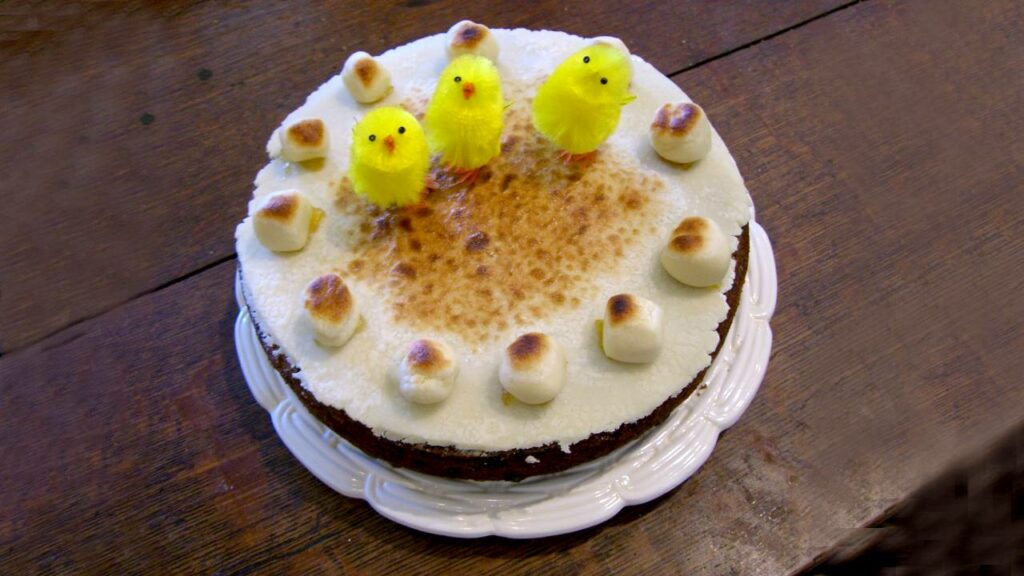Simnel cake is a traditional British fruitcake dessert that plays a significant role during Easter celebrations.
Its origins can be traced back to medieval times, and it originally became associated with Mothering Sunday, a day when young apprentices and girls in service would return home to visit their mothers, carrying a simnel cake as a gift.
This rich fruitcake, made with marzipan and spices, has become a symbol of Easter, akin to fruitcake’s relationship with Christmas.
The classic recipe is distinguished by almond paste or marzipan, typically found in two layers—one in the middle and another on top, decorated with a circle of eleven marzipan balls which represent the eleven faithful apostles, excluding Judas.
Understanding simnel cake is to recognize its dual celebration of the end of the Lenten season and its ties to family reunions on Mothering Sunday. The cake’s specific regional variations add to its charm.
Whether it’s your first time baking or tasting this festive cake, diving into its history can enrich your Easter experience, offering more than just a delightful dessert but a slice of tradition that spans centuries.
Simnel Origins and History
In tracing the roots of simnel cake, you’ll discover links as far back as medieval times and touches upon various locations and historical figures. This dessert’s story is not only about a cake but also the cultural and historical significance it has carried through centuries.
Medieval Roots
Simnel cakes have their origin in the tradition-rich epoch of medieval times. Although the precise beginnings are obscured, it is clear that these cakes were associated with Lent and celebration.
The term ‘simnel’ is thought to derive from Latin ‘simila’, a term for the finest white flour used in baking. These cakes were a luxury, meant to be a treat after the austerity of Lent.
Prominent Simnel Locations
Specific regions became famed for their unique takes on simnel cakes. Shrewsbury and Bury are two such towns.
The Shrewsbury simnel is distinct, employing a different recipe that became a renowned regional variant. Similarly, Bury was historically known for its high-quality simnel cakes, placing these towns on the culinary map.
Historical Figures
Key figures have punctuated the history of simnel cakes. For instance, the story of Simon and Nell, a mythical couple, is often cited wherein Nell fashioned the cake and Simon baked it.
Also notable is Lambert Simnel, who was a pretender to the throne in the reign of Henry VII; although not related to the cake directly, his name often mistakenly attaches itself to the simnel cake’s history. Furthermore, the church played a significant role, as the simnel cake became a considered part of religious festivity.
Culinary Significance
The culinary significance of simnel cake lies in its rich tapestry of ingredients and the traditional methods of preparation. This cake is much more than a sweet treat; it’s steeped in history and symbolism.
Traditional Ingredients
Simnel cake, an English delight, incorporates a variety of traditional ingredients that contribute to its distinct flavor and texture. You’ll need:
- Sugar & Butter: These form the cake’s rich base.
- Eggs: They are crucial for binding the mixture.
- Flour: Typically, plain or wheat flour is used.
- Mixed Spice & Ground Cinnamon: These add depth to the cake’s flavor.
- Dried Fruits: Including currants, sultanas, raisins, and mixed peel that infuse the cake with chewy sweetness.
- Marzipan: It’s a sweet, doughy mixture made primarily of sugar and ground almonds.
The cake is uniquely adorned with 11 marzipan balls, symbolizing the eleven faithful apostles. This decoration is essential and a distinguishing feature of the simnel cake.
Modern Adaptations
While preserving the essence of simnel cake, modern adaptations focus on personal preference and creativity. Your modern simnel might include:
- Cherries & Citrus Peel: To introduce a tart contrast to the sweetness.
- Brandy or Rum: Some recipes call for a dash to enrich the fruit’s flavor.
- Nuts: For added texture, beyond the traditional almonds in marzipan.
- Glacé Cherries: Often added for a touch of color and a different type of sweetness.
With these adaptations, you can transform the time-honored simnel cake into a personalized dessert that maintains its customary foundation while allowing for a contemporary twist.

Symbolism and Celebration
Simnel cake is a rich, fruit-studded confection often enjoyed during Easter, with roots extending into the observances of Mothering Sunday. Its distinctive decorations carry deep religious meaning, tying into longstanding springtime traditions.
Religious and Cultural Significance
Simnel cake is steeped in history, with its 11 marzipan balls symbolizing the 11 faithful apostles, excluding Judas Iscariot who betrayed Jesus. Consumed on Easter Sunday, it marks the end of fasting and penitence of Lent, with the cake’s richness serving as a gastronomical celebration of the resurrection of Christ. Historically, on Laetare Sunday—also known as Mothering Sunday and often considered a precursor to modern Mother’s Day—families would reunite, and children would present their mothers with simnel cake as a token of appreciation, intertwining this cake with both British culture and familial affection.
Festive Traditions
In British tradition, the Lenten period around Easter is rich with customs, with the simnel cake being a notable edible symbol. The use of marzipan to create the 11 apostle representations aligns with a tradition of craftsmanship and artistry in festive foods. Contrasting the heavier, booze-infused fruitcakes common during Christmas, simnel cake offers a lighter, spiced alternative fitting for the transition from the severity of Lent to the joyous celebration of Easter. It embodies the shift from somber reflection to festive celebration, making the cake a centerpiece at Easter gatherings.
Related Easter Ideas: Easter Cheesecake Recipes
Modern Cultural Impact
Simnel cake continues to hold a place in contemporary UK culture. Appreciation of this Easter classic deepens with an understanding of its presence in literature and evolving culinary practices.
Robert Herrick, an English poet, paid homage to simnel cake in his poetry, emphasizing its role in baptism celebrations. In modern times, events like the annual Simnel Sunday in Devizes showcase simnel cake as a continuing tradition. The Wiltshire Heritage Museum even held an event, suggesting the cake’s strong ties to local heritage.
Famous culinary experts like Mary Berry and Nigella Lawson have put their own twist on traditional recipes, keeping the simnel cake relevant in today’s culinary world.
Each year, new recipes surface, offering variations that might include a Gloucester simnel cake or adaptions suited to specific dietary needs. Food historians keep the story alive, tracking these evolving recipes along with the cake’s links to regions such as Lancashire.
Simnel Recipes
Below are a few simnel recipes in case you are ready to try your hand at making one!
- Easter Simnel Cake from BBC Good Food
- Simnel Cake from Paul Hollywood
- Simnel Cake Recipe from Sweet & Savory Meals
Frequently Asked Questions
Simnel cake carries a rich tradition and significance, especially around Easter. Here we cover some common inquiries to unravel its cultural and historical meanings.
What do the marzipan decorations on a Simnel cake symbolize?
The marzipan decorations on a Simnel cake represent the eleven apostles of Jesus, excluding Judas who betrayed him. Two layers of marzipan, one on top and one in the middle, sandwich the fruitcake, and are finished with eleven marzipan balls.
How does Simnel cake fit into Easter traditions?
Simnel cake is deeply woven into Easter traditions, initially associated with Mothering Sunday before becoming a staple at Easter. It marks the end of the Lenten fast, serving as a celebratory dessert that incorporates rich, luxurious ingredients.
What are the origins and historical significance of Simnel cake?
The historical significance of Simnel cake stretches back to medieval times. It is assumed to have originated during the 11th century as a fine bread, which over time evolved into a rich fruitcake, commonly enjoyed during the Easter period.
What role does Simnel cake play in Christian celebrations?
Simnel cake echoes the Christian principle of reflection during Lent. Its consumption on Easter reflects the joy and wealth of the celebration of the resurrection of Jesus Christ, marking a contrast to the preceding period of austerity.
How has the recipe for Simnel cake evolved over time?
Originally, Simnel cake was a simple bread, but over centuries it has evolved into a fruitcake laden with spices, dried fruits, and marzipan. Modern recipes even include variations with different types of nuts and zest for added flavoring.
Can you describe how to incorporate alcohol into a Simnel cake recipe?
To enhance the richness of the cake, you can brush the layers with alcohol, such as brandy or sherry. Alcohol can be added to the fruit mixture prior to baking, giving the cake a moist texture and a deeper flavor profile.



